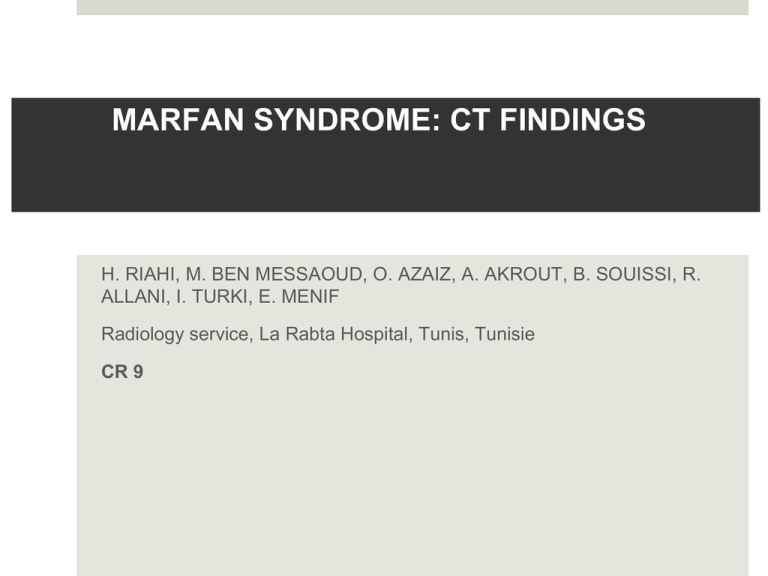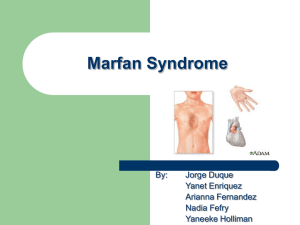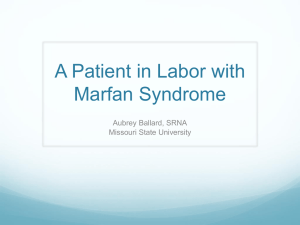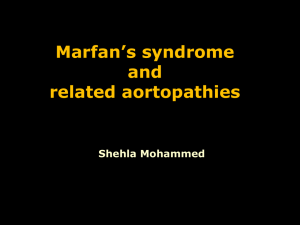MARFAN SYNDROME: CT FINDINGS
advertisement

MARFAN SYNDROME: CT FINDINGS H. RIAHI, M. BEN MESSAOUD, O. AZAIZ, A. AKROUT, B. SOUISSI, R. ALLANI, I. TURKI, E. MENIF Radiology service, La Rabta Hospital, Tunis, Tunisie CR 9 INTRODUCTION Marfan syndrome is a multisystemic connective tissue disorder that affects both sexes equally and is characterized by skeletal, cardiovascular, and ocular abnormalities. Its prevalence has been estimated at two to three persons per .10,000 INTRODUCTION It is an autosomal dominant transmitted disorder (75% –70%of cases) but is also associated with sporadic mutations. The diagnostic process to identify patients with MFS is challenging because it is based on the Ghent criteria, which requires the assessment of a number of clinical, genetic, and radiologic features . OBJECTIVES The aim of this work is to illustrate CT findings in Marfan syndrome revealed by acute chest pain. MATERIEL AND PATIENTS We report the case of 2 patients aged 28 and 32 who were seen in the emergency department with acute chest pain. They underwent contrast enhanced CT. Case 1 28years old woman. Admitted for acute-onset tearing central chest pain that radiates to the back . CT angiography showed: Stanford type A dissection involving the ascending thoracic and the descending aorta Brachiocephalic artery dissection Right renal artery supplied by the false lumen with acute renal infarction a dissection flap in the right brachiocephalic artery Descending aorta dissection Ct also revealed • A severe scoliosis . • A chest wall deformity Case 2 A 32 years old man Complaining of central chest pain and intermittent episodes of excruciating back pain confined to the sacral area . CT showed an annulo aortic ectasia with aortic aneurysms. It also showed a dural ectasia scoliosis DISCUSSION Marfan syndrome may affect various systems, including the cardiovascular, musculoskeletal, central nervous, pulmonary, ocular, and integumentary systems . Diagnosis is based on the revised 1996 Ghent criteria, which include cardiovascular, ocular, and pulmonary abnormalities. The presence of either two major features and one minor feature or one major feature and four minor features supports a diagnosis of Marfan syndrome. Cardiovascular Manifestations Cardiovascular major criteria include • dilatation of the ascending aorta (involving at least the sinuses of Valsalva) • with or without aortic regurgitation , • as well as dissection of the descending aorta. Minor criteria consist of • dilatation or dissection of the descending or abdominal aorta before the age of 50 years, • dilatation of the main pulmonary artery before the age of 40 years, • mitral valve prolapse, and calcification of the mitral annulus before the age of 40 years Cardiovascular Manifestations 1. Annuloaortic Ectasia and Aortic Aneurysm: Annuloaortic ectasia, especially with dilatation of the aortic root, is found in 80% –60%of adults with Marfan syndrome. In annuloaortic ectasia, severe aortic regurgitation occurs that may progress to aortic root dissection or rupture Cardiovascular Manifestations • Aortic aneurysm without annuloaortic ectasia also is common . • Compared with atherosclerotic aneurysms, it occur in younger patients and enlarge more rapidly. • The diameters of the dilated ascending aorta, sinotubular junction, and aortic root are clearly demonstrated on multiplanar CT images obtained with three-dimensional reconstruction techniques. Cardiovascular Manifestations . 2Aortic Dissection • Dissection develops more often in young patients with Marfan syndrome than it does in the general population. • Multidetector CT is the radiologic modality most frequently used for diagnosis of aortic dissection . • It clearly demonstrates the extent of dissection, the relationship of the true lumen and false lumen, and any involvement of major aortic branch vessels. Cardiovascular Manifestations .3Pulmonary Artery Dilatation • Dilatation of the main pulmonary artery is one of the established criteria for the diagnosis of Marfan syndrome. Like dilatation of the ascending aorta, it occurs predominantly in the root. • The upper limits of a normal main pulmonary artery diameter at the root and at the level of bifurcation, were 34.8 mm and 28.0 mm, respectively Musculoskeletal Manifestations 1. Scoliosis • Scoliosis is a frequent and potentially severe manifestation of Marfan syndrome. It occurs in approximately 62% of patients. • Scoliosis in Marfan syndrome is more severe, rigid, and progressive, requiring surgical correction. • When it occurs in combination with straight back syndrome, kyphosis, or a chest wall deformity, it may contribute to cardiopulmonary compromise and restriction of lung volume Musculoskeletal Manifestations • Measurement of the severity of a scoliotic curve has practical applications and the Lippman-Cobb method is widely used to measure the degree of scoliotic curvature. • CT and MR imaging are helpful to evaluate the bone structure, associated abnormalities of the spinal cord, and the nerve roots before treatment planning. Musculoskeletal Manifestations .2Chest Wall Deformity • Approximately 66% of patients with Marfan syndrome have either pectus excavatum or pectus carinatum produced by longitudinal overgrowth of the ribs. • The severity of pectus excavatum is determined according to the pectus index calculated on the basis of measurements on CT images. Musculoskeletal Manifestations .3Acetabular Protrusion • Acetabular protrusion is a deformity of the hip joint and is distinguished by the invasion of the acetabulum and femoral head into the pelvic cavity. • Radiographic findings, including an increased centeredge angle of Wiberg and an obscured teardrop sign, allow the diagnosis. Dural Ectasia and Associated Central Nervous System Manifestations • Dural ectasia, which has been observed in 65% –56%of patients with Marfan syndrome, is a ballooning or significant widening of the dural sac or neural root sleeves. • It is sometimes accompanied by bone erosion, meningoceles, and arachnoid cysts. • Most occurrences of dural ectasia in Marfan syndrome affect the lumbosacral spine. • Dural ectasia is depicted on radiographs as a widening of the interpediculate distance. • Vertebral body scalloping occurs with a high prevalence in transition vertebrae. MR imaging and CT are the reference standards for diagnosis of dural ectasia. Dural ectasia appears as widening of the dural sac, dilatation of the nerve root sleeve, and scalloping of vertebral bodies in the lumbosacral spine on MR and CT images. In addition, MR and CT images may demonstrate an accompanying meningocele or arachnoid cyst Pulmonary Manifestations The lungs are rarely involved in Marfan syndrome. various pulmonary manifestations have been described, including interstitial parenchymal disease and honeycombing, diffuse and apical bullous emphysema ,congenital malformation of the bronchus, bronchiectasis, and spontaneous pneumothorax. CONCLUSION With the increasing availability of whole-body imaging with multidetector CT or MR imaging, the role of the radiologist has expanded beyond the simple achievement of a diagnosis of Marfan syndrom to include the comprehensive identification of its various systemic manifestations. In patient without a family history of Marfan syndrome, computed tomography can play an impotant role in diagnosis by identifying one of major cardiovascular criteria or dural ectasia








